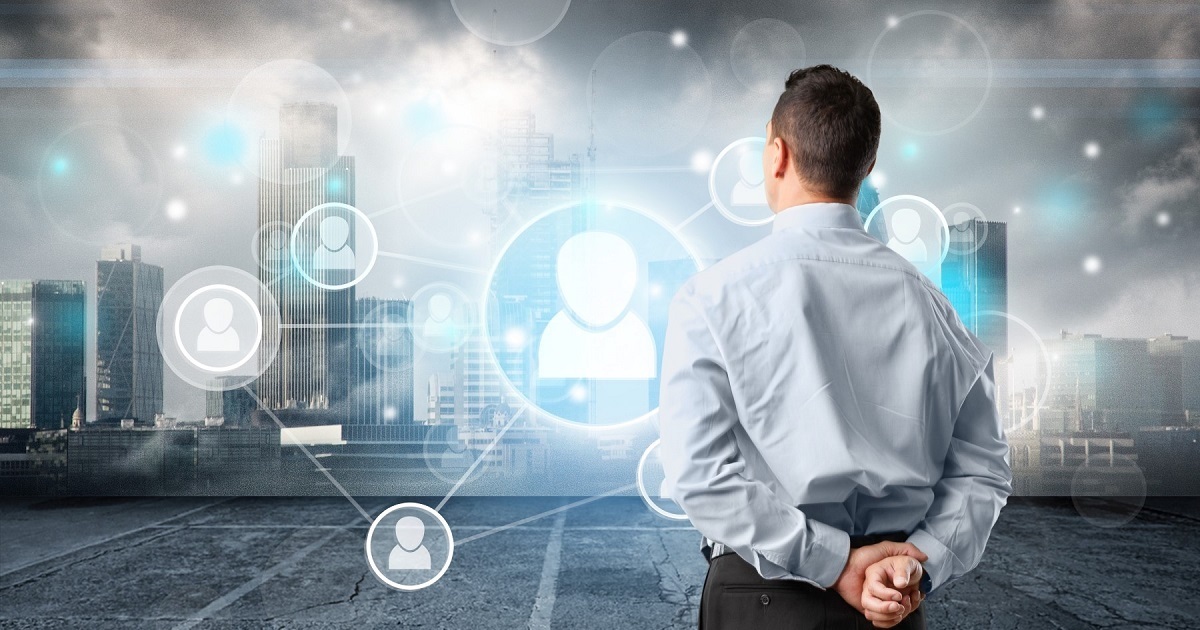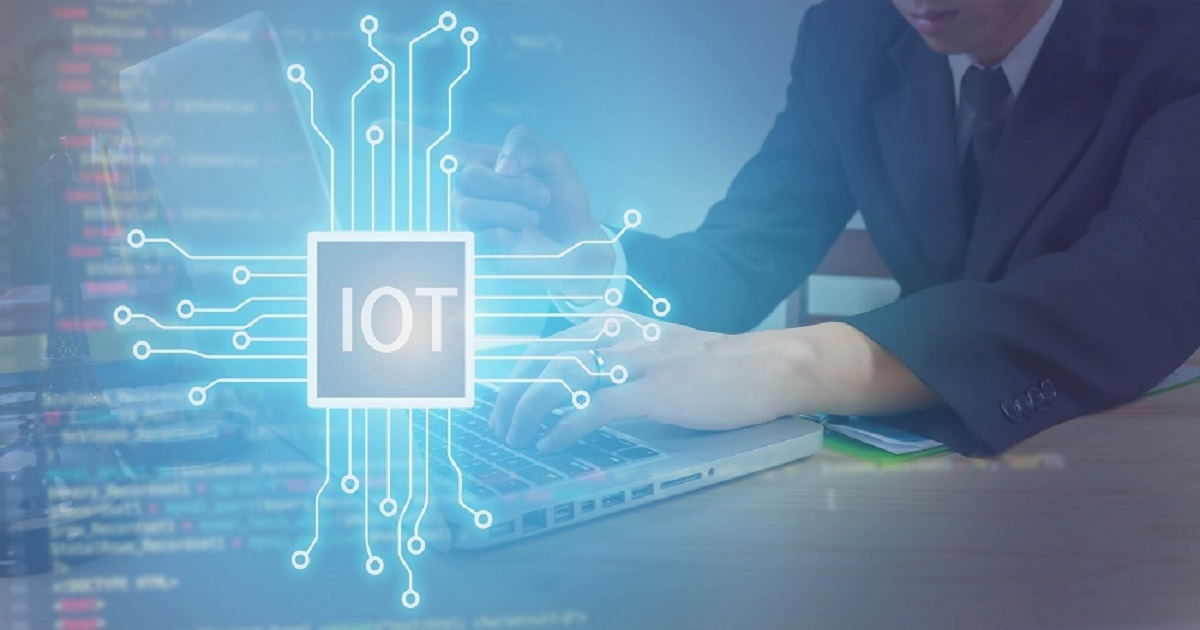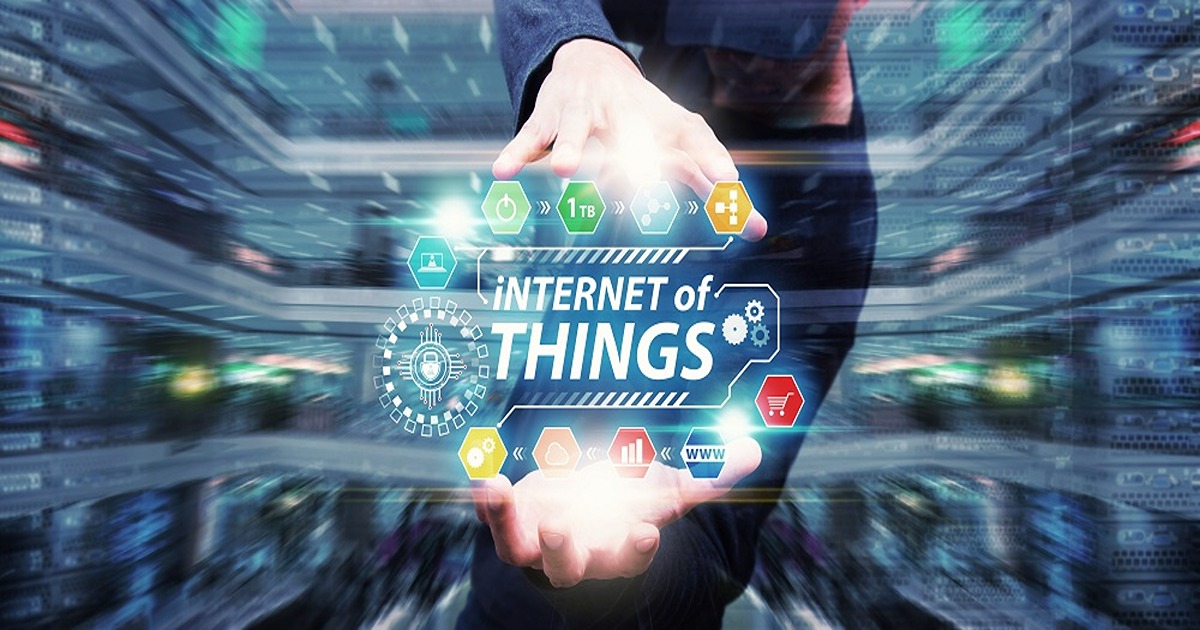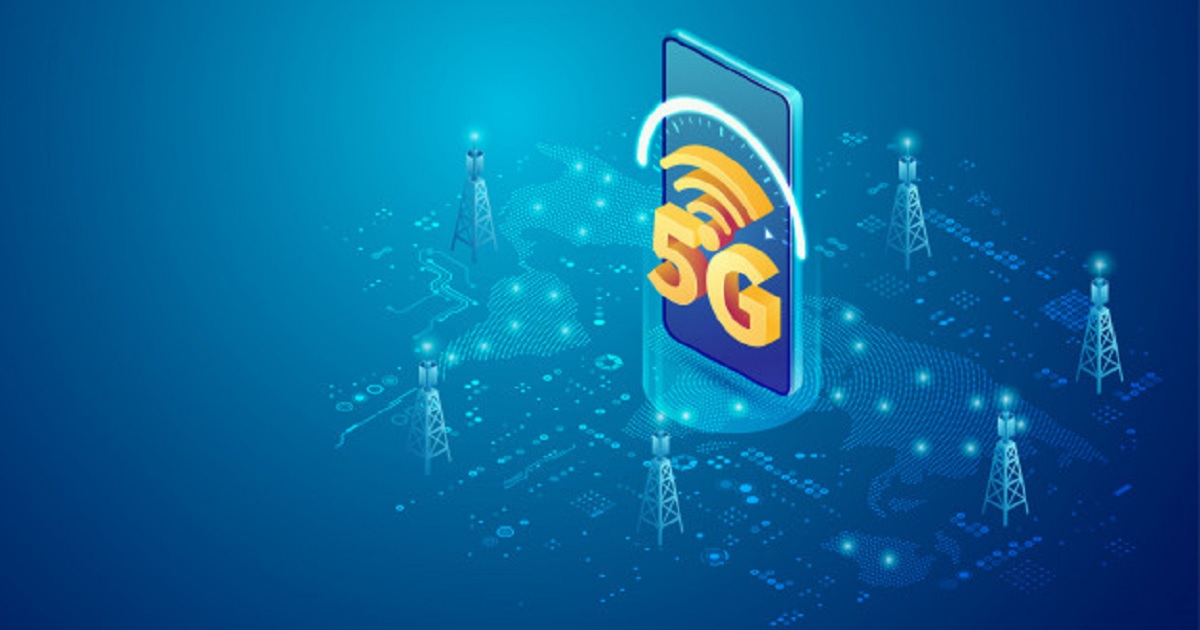
IoT Security
Article | June 27, 2023
Artificial intelligence (AI) has already made headway into becoming a general-purpose technology vastly impacting economies. Yet, the interpretation and estimated trajectory for something remotely close to what we call AI now was first explored in the 1950s.
Until this very day, AI keeps on evolving further. Though let’s face it, AI would have been useless without data. With around 2.5 quintillion bytes of data being generated every day, the numbers will shoot up as the Internet of Things (IoT) enters the game.
Let’s see what this is all about and where and how exactly IoT crosses paths with AI applications.
IoT fundamentals: Where does IoT meet AI
The benefits of IoT in AI
Challenges of IoT in AI
Why implement machine learning in IoT
IoT applications for AI
Key takeaways
IoT fundamentals: Where does IoT meet AI?
What is meant by the term internet of things (IoT) is essentially a system of correlated digital and mechanical appliances, computing devices, and sensors embedded often into everyday objects that transfer data over a network. IoT connects the internet to any and every physical thing or place in the world.
Modern IoT has advanced from the mere merging of microelectromechanical systems to wireless technologies, and faster data transfer through the internet. This resulted in a confluence of information technology and artificial intelligence, allowing unstructured machine-generated data to be evaluated for insights that could lead to new developments.
More and more industries are now referring to IoT to function more proficiently, provide better customer service, escalate the significance of their business, and implement robust decision-making.
Machine learning for IoT can be used to identify anomalies, predict emerging trends, and expand intelligence through the consumption of audio, videos, and images. The implication of machine learning in IoT can substitute manual processes and offer automated systems using statistically backed up actions in critical processes.
The benefits of IoT in AI and real life
IoT offers the following benefits to AI applications:
IoT data for business purposes
Cost and time savings
Task automation and reduction of human intervention
Higher quality of life
IoT data for business purposes
IoT can also be viewed as a data pool. That means by aggregating IoT data, one can extract useful data-driven feedback, which in turn (used properly) may foster effective decision-making. Businesses can also identify new market opportunities, not because of IoT itself but by using the data IoT provides. And since IoT offers companies access to more data, and hence advanced analytics of that data, its usage can eventually result in improved customer outcomes and enhanced service delivery.
Cost and time savings
When devices get connected, cost reductions come along with it. The gathering of different data allows for advances in efficiency, and it leads to money surplus and low-cost materials.
Task automation and reduction of human intervention
Nowadays, devices that are internet-connected can be found in every aspect of our lives, and it is safe to say that they make tasks easier. These automation features range from real-time AI-powered chatbots to home automation control systems, and all of it usually takes a click of a button.
For businesses offering AI-enabled solutions, similar advancements can be achieved with pipeline automation too. That includes significant cuts in annotation and QA time. By leveraging SuperAnnotate’s platform, hundreds of companies recorded faster task completion and more accuracy in prediction results.
Higher quality of life
IoT is not only beneficial in the business aspects but it also creates better living circumstances for us. Smart cities and agriculture, intelligent homes, and food waste solutions are some of the most common ways of IoT providing better, more sustainable living conditions for people.
Challenges of IoT in AI
Despite the numerous benefits and advancements that IoT brings to the table, there have been a few limitations with it. Some of them are listed below:
Privacy issues
Data overflow
Bug issues
Compatibility issues
Privacy issues
With the increased connection between multiple devices or their coexistence for model development purposes, more information is shared between them, which poses vulnerability to your data and makes room for caution. Added layers of protection are needed to prevent risks of data leaks and other threats.
Data overflow
Eventually, organizations will have to find a way to deal with the large numbers of IoT devices, and that will include the collection and systematic management of all the data from those IoT devices. The proper use of data lakes and warehouses, close governance, and intuitive arrangement of datasets will become an utmost priority.
Join hundreds of leading companies who build super high-quality training data up to 5x faster using SuperAnnotate’s intuitive data curation and robust project management features.
Bug issues
If one IoT device has a bug in its system, there is a large chance that every other connected device will also have it.
Compatibility issues
Because there are no international standards of compatibility for IoT, it's harder for different devices to communicate with one another.
Why implement machine learning in IoT
More and more companies are combining IoT with machine learning projects so they can achieve analytical skills on a large variety of use cases which allows their businesses to have access to fresh insights and adopt innovative automation. By implementing machine learning for IoT, they can leverage the following:
Convert data into a coherent format
Arrange the machine learning model on device, edge, and cloud
Enable use of data on edge devices directly for complex decision making
IoT applications for AI
Although we have covered the basics of IoT, its implications for AI are not as simple. Many corporations are adopting IoT which allows them to have an advanced approach to growing and advancing their business. Novel IoT applications are offering organizations the ability to plan and implement more vigorous risk management strategies. Some of the more common uses of IoT in AI encompass the following:
Transport logistics
Not only does IoT expand the material flow systems in transport logistics, but it also improves the automatic identification and global positioning of freight. It also increases energy efficiency and consequently declines the consumption of energy.
Smart cities
Although the term smart city is still incomplete, it mainly refers to an urban area that endorses sustainable enlargement and high quality of life. Giffinger et al.’s model explains the features of a smart city, including the people, the government, the economy, and lifestyle.
E-health control
The two main objectives of future health care are e-health control and prevention. People nowadays can choose to be monitored by physicians even if they do not live in the same country or place. Tracing and monitoring peoples’ health history makes IoT-assisted e-health extremely useful. IoT healthcare solutions could also benefit the specialists, as they can collect information to advance their medical calculations.
Key takeaways
Ever since its development, IoT, especially AI-enabled IoT, as discussed, has been enhancing our daily lives and directing us to work smarter while having complete control over the process. Besides having smart appliances to elevate homes, IoT devices can also be essential for providing insights and an actual look for businesses into their systems. Heading forward, IoT will continue to develop as more organizations get to understand its potential usage and tangible benefits.
Read More

IoT Security
Article | June 28, 2023
Understanding the Impact of IoT Device Management
The Internet of Things (IoT) industry is growing exponentially, with the potential to become limitless. The current range of existing and potential Internet of Things devices is in itself quite enormous. This also gives businesses an opportunity to pay more attention to the newest technologies.
In ascenario with rapidly increasing numbers of devices, manual management of devices becomes close to impossible, laced with human errors. Moreover, keeping an eye on hundreds of devices one by one to make sure they work the way they should is not an easy task to undertake.
Businesses at the outset of IoT adoption are most often unaware of why they require a device management platform.This is precisely why a device management platform is so crucial.It can effectively connect toall of theconnected devices and get the required information from them in the right way.
An effective device management platform can turn out to be the vital aspect that will define the success of any small or large IoT implementation project. Such a platform would ideally allow organizations to manage their internet-connected devices remotely.
"If you think that the internet has changed your life, think again. The IoT is about to change it all over again!" — Brendan O'Brien, Chief Architect & Co-Founder, Aria Systems.
Why Do Organizations Need an IoT Device Management Platform?
An effective IoT device management platform offers simplified provisioning, centralized management, and real-time insights into all existing devices and integrations to help organizations stay on top of their deployment.
Device management platforms help you keep a check on the growing number of devices while keeping errors at bay, with your growing number of connected devices. It would ensure that you have a clear dashboard and an alerting system as an effective supporting system. In addition, getting involved with IoT device management platforms can also help you in a number of other ways.
It acceleratestime-to-market and helps reduce costs
The management platform enables secure device on and offboarding
It also streamlines network monitoring and troubleshooting
IoT simplifies deployment and management of downstream applications
It mitigates security risks
Evaluating the Future of IoT Device Management
It is predicted that the world will have more than 100 billion IoT-connected devices by 2050. The future potential of the IoT is limitless, and the potential is not about enabling billions of devices together but leveraging the enormous volumes of actionable data thatcan automate diverse business processes.
Critical Aspects of the IoT's Future
The critical aspects of IoT predictionsare fast impacting several categories all across the globe, ranging from consumer to industrial.
IoT Companies and a Circular Economy
IoT firms are assisting in the development of a future with less waste, more energy efficiency, and increased personal autonomy. A connected device system, on the other hand, must be feedback-rich and responsive, and activities must be linked via data in order to be sustainable. Ways to achieve a responsive and actionable system include:
Extending the use cycle with predictive maintenance.
Increasing utilization and reducing unplanned downtime.
Looping the asset for reuse, remanufacture, or recycle.
Common Billing and Revenue Challenges
We are currently moving toward a future where everything from cars to household machines and home security will be sold by manufacturers as subscription services. This will result in organizations selling IoT subscriptions looking for new ways to managebilling and revenue for their business model.
Service diversity
Data monetization
Complex stakeholder network
Cost management
Cohesive IoT Deployment Strategy for the C-suite
With the future of IoTon its way to becoming the most disruptive innovation and compelling technology that will facilitate better services to customers, from a support perspective, being connected remotely with customers' devices offers considerable advantages to service organizations. However, this is also not a new concept; earlier, large organizations and data storage companies were remotely connected to their client systems using dedicated telecommunications links before the commercialization of the internet.
Using the estimates of the exponential rise in connected devices, the IoT offers a wide array of opportunities to effectively improve the industry, such as:
Consumer activity tracking includes in-store applications that assess traffic flow and purchase choices.
Manufacturing, storage, distribution, and retail operations have been optimized to increase productivity and reduce waste.
Energy, inventory, and fleet assets are all used more efficiently.
Improved situational awareness, such as vehicle warning systems
Enhanced decision-making, such as medical equipment that notifies doctorswhen a patient's health changes.
Self-parking and self-driving automobiles are examples of autonomous systems.
An interesting case study with Michelin showed that they were adding sensors to tires to better understand wear over time. This data is important for clients to know when to rotate or replace tires which saves them money and enhances safety. However, this also implies Michelin can move away from selling tires and instead lease them. Because sensor data will teach the corporation how to maintain the tires, Michelin now has a new economic incentive to have tires last as long as feasible. IoT device management plays a crucial role in effectively accumulating and processing data from all the widely distributed IoT sensors.
Conclusion
As more sectors discover the advantages linked machines can bring to their operations, IoT enterprises have a bright future ahead of them. Newer services are steadily being pushed out on top of IoT infrastructure in industries ranging from healthcare to retail, telecommunications, and even finance. Due to increasing capacity and AI, service providers will move deeper into IT and web-scale industries, enabling whole new income streams as IoT device management platforms adapt to address these obstacles.
FAQ
Why Is Device Management Crucial for the IoT?
An IoT device management platform's features may help you save time and money and increase security while also providing the critical monitoring and management tools you need to keep your devices up-to-dateand optimized for your unique application requirements.
What Impact Will the IoT Have on the Management or Administration Sectors?
IoT technology allows for increased collaboration, but it will also free up your team's time from monotonous and isolating duties. For example, routine chores may be encoded into computers, freeing up time to concentrate on higher-order tasks.
What Are the Basic Requirements for IoT Device Management?
The four essential needs for IoT Device Management are as follows.
Authentication and provisioning
Configuration and Control.
Diagnostics and monitoring
Updating and maintaining software.
Read More

IoT Security
Article | July 17, 2023
Physical and digital security are changing due to cloud-based IoT software, which makes it possible to combine them and use them to utilize data better. In almost every sector, data is essential to success, and security is no exception. To better understand what's going on in your business, you can combine cloud-based solutions that contain all the information on a single interface. For instance, integrating security camera feeds with cloud-based access control systems enables real-time visual identification verification.
Utilizing cloud-based IoT technology also enhances productivity and enables quick replies. Combining digital and physical security, often known as security convergence, is another technique to optimize IoT and cloud-based security solutions. To guard against internet flaws and intrusions, a cloud-based physical security system needs cybersecurity software. In a similar vein, physical security measures prevent sensitive data from getting into the wrong hands. Teams for physical and cyber security might combine to provide a more comprehensive plan of action.
Maintaining current versions of the technology you are using in your security plan is necessary for future-proofing your technology. To ensure that your cloud-based system has no vulnerabilities that could expose your company to cybersecurity risks, it is crucial to keep all software updated. Updates can be automated and carried out remotely with cloud-based software, requiring little effort on your part to keep your software current.
You have the chance to develop a security system that is future-proof when a firm adopts cloud-based IoT technologies as part of your security plan. When organizations use IoT technology, cybersecurity is a significant concern. However, combining physical and digital security lets you ensure your cloud-based system is well-protected from vulnerabilities. In addition, your security and IT teams will be better able to manage the evolving security landscape if you combine physical and digital security ideas.
Read More

Article | June 25, 2020
The year 2020 was supposed to be a breakthrough year for many technologies but, most businesses have now been forced back into building an infrastructure to transit their workforce to work remotely and ensure continuity of workflow. Nevertheless, an unprecedented set of events have pushed several industries to accelerate the adoption of technologies as they continue to work from home.
5G and Wi-Fi 6 are two tech advancements that have been turning eyes around the world since their introduction. The two wireless technologies are well on their way to revolutionize the Internet of Things as businesses move fast towards digitization and the world is excited.
Table of Contents:
- Wi-Fi 6: A Breakthrough in Wireless Technology
- 5G: For a Better Connected World
- How are Wi-Fi 6 and 5G Transforming the IoT?
- 5G and Wi-Fi 6: Rivals or Allies?
Wi-Fi 6: A Breakthrough in Wireless Technology
The next-generation Wi-Fi with boosted speed was introduced last year to meet the demand for faster internet amongst the rising internet users. But, Wi-Fi 6 is simply more than a tweak in the speed.
Technically called 802.11ax, Wi-Fi 6 is the advancement in the wireless standard doing the same basic things but with greater efficiency in the device-dense areas, and offering much greater bandwidth than its predecessor 802.11ac or Wi-Fi 5. Wi-Fi 6 promises a speed up to 9.6 Gbps up four times than that of Wi-Fi 5 (3.5Gbps). In reality, this is just a theoretical maximum that one is not expected to reach. Even still, the 9.6Gbps is higher speed and doesn’t have to go to a single device but split up across a network of devices.
A new technology in Wi-Fi 6 called the Target Wake Time (TWT) lets routers set check-in times with devices, allowing communications between the router and the devices. The TWT also reduces the time required to keep the antennas powered to search for signals, which in turn also improves battery life.
Wi-Fi 6 also comes with a new security protocol called WPA3, making it difficult to hack the device passwords by simple guesswork.
In short, Wi-Fi 6 means better speeds with optimized battery lives, and improved security.
5G: For a Better Connected World
5G is the next in line to replace 4G LTE. While Wi-Fi covers small scale internet requirements, cellular networks like 5G are here to connect everyone and everything virtually on a larger scale.
The technology is based on the Orthogonal frequency-division Multiplexing (OFDM) that reduces interference by modulating a digital signal across several channels. Ability to operate in both lower bands (like sub-6 GHz) and mmWave (24 GHz and above), 5G promises increased network capacity, low latency and multi-Gbps throughput. 5G also uses the new 5G NR air interface to optimize OFDM to deliver not just better user experience but also a wider one extending to many industries, and mission-critical service areas.
The 5G technology, in a nutshell, has brought with it ultra-high speeds, increased and scalable network capacity, and very low latency.
How are Wi-Fi 6 and 5G Transforming the IoT?
5G and Wi-Fi 6 will fill up the speed gaps that our existing networks are not able to especially, in crowded homes or congested urban areas. It's not just about the speed. The two wireless technologies will increase network capacity and improve signal strengths.
On the business front, 5G and Wi-Fi 6 are both living up to the hype they created since their introduction.
Wi-Fi 6 has emerged, as the enabler of converged IoT at the edge. It has put IT into OT applications, connected devices and processed data from devices such as IP security cameras, LED lighting, and digital signage with touch screen or voice command. Wi-Fi 6 can now be used in office buildings for intelligent building management systems, occupancy sensors, access control (smart locks), smart parking, and fire detection and evacuation.
It’s (Wi-Fi 6) built for IoT. It will connect many, many more people to mobile devices, household appliances, or public utilities, such as the power grid and traffic lights. The transfer rates with Wi-Fi 6 are expected to improve anywhere from four times to 10 times current speeds, with a lower power draw, i.e. while using less electricity.
- Tom Soderstrom, IT Chief Technology and Innovation Officer at NASA’s Jet Propulsion Laboratory (JPL)
Similarly, 5G will open doors for more devices and data. It will increase the adoption of edge computing for faster data processing close to the point of action. The hype around 5G is because of the three key attributes it comes with: enhanced mobile broadband (eMBB), ultra-reliable low-latency (uRLLC), and massive IoT device connectivity (mMTC). But there is the fourth attribute that sets it apart from its predecessor: use of a spectrum that operates at the low-end frequency range (typically 600 MHz). Called as ‘low-band 5G’, it delivers high speeds with signals that go for miles without propagation losses and ability to penetrate obstacles. The 5G operates in the new millimetre-wave bands (24 to 86 GHz) delivering more capacity to enable many low-power IoT connections.
If we were to point down the benefits, these two wireless technologies are bringing to the Internet of Things those would be:
Increased Human-Device Interactions
Increased Data and Devices
More IoT investments
Advancing to the Edge
Acceleration towards Industrial IoT
Enhanced use of IoT devices
Better VUI
5G and Wi-Fi 6: Rivals or Allies?
In February, Cisco estimated that by 2023 M2M communications will contribute to 50% or about 14.7 billion of all networked connections. Cisco’s Annual Internet Report reveals that 5G will enable new IoT applications with greater bandwidth and lower latencies and will accelerate innovations at scale. The same report estimates that 10.6% of global mobile connections in 2023 will be 5G, while Wi-Fi 6 hotspots will be 11.6% of all public Wi-Fi hotspots growing 13 times from 2020 through 2023.
Wi-Fi6 will serve as a necessary complement to 5G. A significant portion of cellular traffic is offloaded to Wi-Fi networks to prevent congestion and degraded performance of cellular networks (due to demand).
- Thomas Barnett, Director of Thought Leadership, Cisco Systems
The two technologies are here to feed different data-hungry areas with gigabit speeds.
With lower deployment costs, Wi-Fi 6 will be dominating the home and business environments where access points need to serve more users covering devices like smartphones, tablets, PCs, printers, TV sets, and streaming devices. With an unlicensed spectrum, the performance of Wi-Fi 6 depends on the number of users, that are using the network at the same time.
5G, with its longer range, will deliver mobile connections and accelerate smart city deployments and manufacturing operations. Like LTE, 5G speeds will depend upon users’ proximity to base stations and the number of people using that network.
The performance of the two depends largely on the area where they are being deployed. For instance, Wi-Fi can very well handle machine-to-machine communications in a managed manufacturing unit, whereas 5G can enhance campus-wide manufacturing operations efficiently. Businesses will have a decision to make which among the two wireless networks fulfils their data appetite.
In conclusion, the two wireless technologies continue to develop in parallel and causing the next big wave in the Internet of Things.
Read More